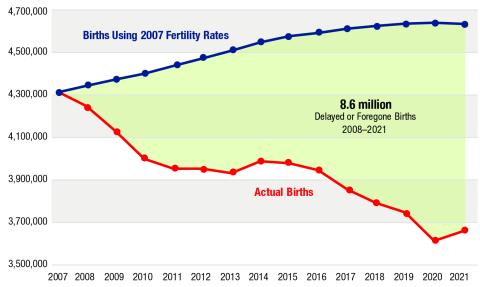download the Data Snapshot
Key Findings

National Center for Health Statistics data for 2021 show a slight increase in births, rising 1.5 percent from the 2020 level which was a 40-year low. Even with the uptick, the 3,659,000 births in 2021 were the third fewest in 40 years. There is little to suggest a substantial increase in fertility rates in the short term, though preliminary data suggest that births in the first three months of 2022 were higher than in early 2021 when COVID first impacted births. Contemporary trends continue a birth decline that began in the era of the Great Recession. The extent of this slowdown in births over the past 14 years is reflected in the fact that there were 657,0000 fewer births in 2021 than in 2007: a 15.2 percent decrease. This birth decline occurred even though the number of women in their prime childbearing years (aged 20–39) rose by 8.5 percent. Births diminished because fertility rates declined significantly among women in their teens and twenties. Fertility rates diminished modestly among women in their early thirties and increased among older women. The long-term impact of the fertility declines has been substantial. Had 2007 fertility patterns been sustained through 2021, there would have been 8.6 million more births in the last 14 years. One stark statistic reflects the impact of continuing low birth rates coupled with increasing deaths due to COVID: more people died than were born in 73 percent of U.S. counties in 2021—the most in U.S. history. A critical long-term question is: how many of these births are being delayed, and how many will be foregone? Women who delayed fertility because of the Great Recession are now further challenged by COVID-19 and many are approaching the end of their childbearing years. Had the fertility patterns of 2007 been sustained, 3 million more women would have had at least one child by 2020. This has implications for health care, schools, child-related businesses, and eventually for the labor force.

Source: National Center for Health Statistics, 2021

Kenneth M. Johnson is senior demographer at the Carsey School of Public Policy, professor of sociology at the University of New Hampshire, and an Andrew Carnegie Fellow. His research was supported by the New Hampshire Agricultural Experiment Station in support of Hatch Multi-State Regional Project W-4001 through joint funding of the National Institute of Food and Agriculture, U.S. Department of Agriculture, under award number 1013434, and the state of New Hampshire. The opinions are his and not those of the sponsoring organizations.